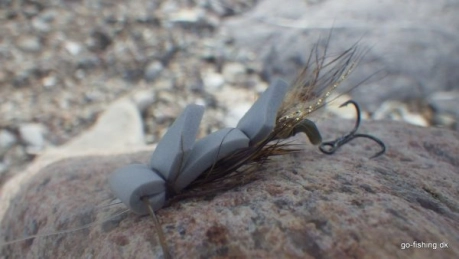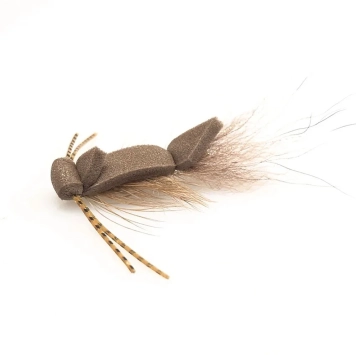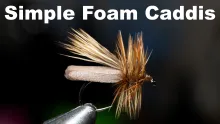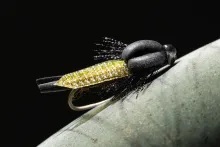Fishing Baltic sea trout in the surface with waking foam flies can be a lot of fun. Here’s how to do it – and a pattern that works.
After the release of Niels Vestergaard's video Sea Trout Secrets 8, I have received a lot of questions regarding the film's chapter on foam fly fishing.
Questions like:
How do the flies look in detail?
When is foam fly fishing best?
Which coastal types are best suited for foam fly fishing?
Which hook is used for the flies?
What kind of a weird angle rig is that holding the hook?
Isn't it just a fad? Isn't a shrimp fly the best bet anyway?
- Just to mention a few.
And admitted – I should have spent more time in the film explaining the whole setup. I'm trying to make that better here.
I fish foam flies because it's fun. Seeing your fly disappear from the surface in a whirl and feeling the line tightening up, gives you a kick that is better than anything else. I'm personally almost addicted to it.
When I say foam flies, I mean a floating fly that is actively fished in the surface. Not to be confused with classic dry fly fishing for fish that are already seeking food on the surface, and where the fly is fished more or less still.
I also sometimes fish with shrimp and worm flies that have a strip of foam on the back. It causes the fly to fish high in the water, but without breaking the surface, and is not what I call proper foam fly fishing.
Foam flies are flies that fish streaking in the surface throughout the length of the cast.
Surface flies have been known as good for night fishing long before I started my coastal fly career. I only fished with surface flies at night during my young years. I introduced the Black Cigar among other patterns for the sea trout of the coast in the early nineties. Later, I made the Black Marshmallow. Back then we stopped fishing the surface flies as soon as the light came in the morning. Surface flies were only for the dark. But a couple of times, after a long night's fishing, I was simply too tired or lazy to change. Many a time I experienced seeing the summer sea trout strike the Black Cigar long after the sun had risen.
Later I visited Greenland, and saw a world-class fishing with foam flies after char, both in the rivers and out along the Greenland coast.
The experiences really made me start the experiments with foam fly fishing in daylight for Danish coastal trout. I was very pleasantly surprised Today – after seven or eight foam fly seasons I have a pretty good picture of the fishing:
The foam flies can be fished all year round, but are best when the water temperature reaches 7-8 degrees C. When that happens, the foam fly can easily fish as well as the best traditional coastal flies on some days.
There are even days where they are clearly better. I have experienced this primarily in August/September. On the other hand, there are also days when the sea trout only come up and looks at the surface fly. It is revealed a wake behind the fly, but the lack of a take. If this happens repeatedly, switch to a smaller fly that fishes just below the surface.
Most days, however, sea trout go deliberately after the fly. Small fish may have difficulty in "catching" them, and may come several times to the fly, in the same, or consecutive throws. Larger fish have a better chance to actually grab the fly in the first attempt. Either way, it is visually exciting and great fun to experience. In fact, it is so exciting to follow the foam fly's movement in the surface that I can become completely tired in my eyes after staring at the fly out there all day. When that happens, I switch to a shrimp fly and blind fish for 10-15 minutes while the eyes are resting, and get ready for another period of concentrated foam fun again.
I catch fish on foam at all coastal locations.
In the fjord, in the through, along the coastal cliffs, on the stone reefs and everything in between and most days with lots of action, even when I haven't seen fish in the surface. A foam fly that fishes splashing and streaking in the surface easily lures a sea trout that already has the belly filled with scuds or worms.
In short: I don't find the foam flies better than my regular coastal flies, but often just as good. In addition, they are much more fun to fish – so the first choice is often a foam fly – but not always.
No scouting for birds or mermaids...
The whole idea with the foam flies is that you are able to see and experience the excitement when a fish shows interest in the fly.
Because of this, it makes no sense to fish with foam flies if you cannot see the fly on the surface. I do not use foam flies in waves (although they also work there) or if deep and deep wading is required, limiting my view range.
The experience is total when the fish comes up to a foam fly on a completely smooth surface – but of course fish are always finicky in dead calm water. Still, foam fly fishing is good weather fishing. A totally calm surface is of course a dream to fish, revealing every move and strike, but the fish can, however, be mischievous when the surface is mirror smooth. They come up and make a wake behind the fly, follows it a little and then disappear. And you cannot lure them back again. I have the best experience when the surface is riffled by a light back wind. In these conditions the fish take more aggressively, and will gladly come again if they miss the first attempt.
Foam also fails when you need to cover a lot of water quickly. The surface fishing is a more calm style of fishing using light tackle, short concentrated casts and full focus on what happens around the fly. No scouting for birds or mermaids...
The foam flies are simple creations with a little tail, a lot of foam of course and maybe a little hackle or rubber legs. My experience tells me that one color isn't better than the other. It is the fly's movement in the surface that is crucial. I often use shrimp colors like gray or tan, but have caught fish on pink, black and even blue foam flies.
My standard pattern looks like this:
The fly can be tied on either a tube or a hook. I use both. The hook version is easiest to tie and fish with. The tube fly version floats a little better, and makes more noise in the surface.
If you tie on tubes it's important to ensure good hooking. This is obtained by having the small treble hook hanging at a 90 degree angle behind the fly. This can be done by tying a so-called L-rig or even more easily installing a small angled rubber gimmick called a "Radical Bent Hook" or a "Bent Hook Aligner" as a hook guide. It ensures that the treble hook, tied onto the tippet with a loop knot, sits properly and hangs under the tube. With that assembly even the most cautious fish, just barely touching the rear of the fly will be hooked. I use an Owner treble hook model ST36-BC size 14 – it works scary well.
If you are not a fly tier, there are several good foam flies to be bought in the shops, like the Chernobyl Ant as well as large foam hoppers and beetles.
Normally I always fish with a fluorocarbon tippet. Except when I'm foam fly fishing. Then you need a good old-fashioned nylon tippet. I use a 9 foot leader with a 0.28 mm tip, extended with a 0.25 mm tippet, giving me about 12 feet overall. Fluorocarbon sinks and draws the foam flies under the surface in the last half of the retrieve. You don't want that to happen, since it's often in that last part things happen...
 This article is a translation of an article written by Claus Eriksen, the managing director of the Danish fishing shop Go Fishing. It was originally published on Go-Fishing's web site, and can be found there in Danish.
This article is a translation of an article written by Claus Eriksen, the managing director of the Danish fishing shop Go Fishing. It was originally published on Go-Fishing's web site, and can be found there in Danish.You can also follow Claus on Facebook.
...a kind of sea trout fishing you just have to try.
- Log in to post comments
























